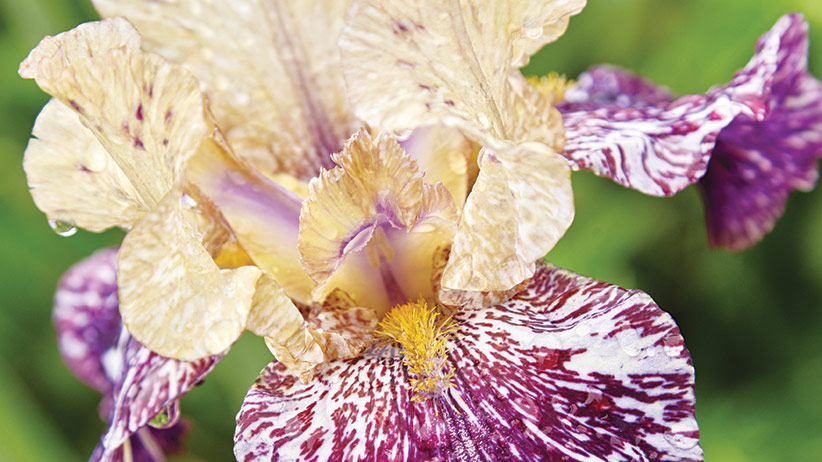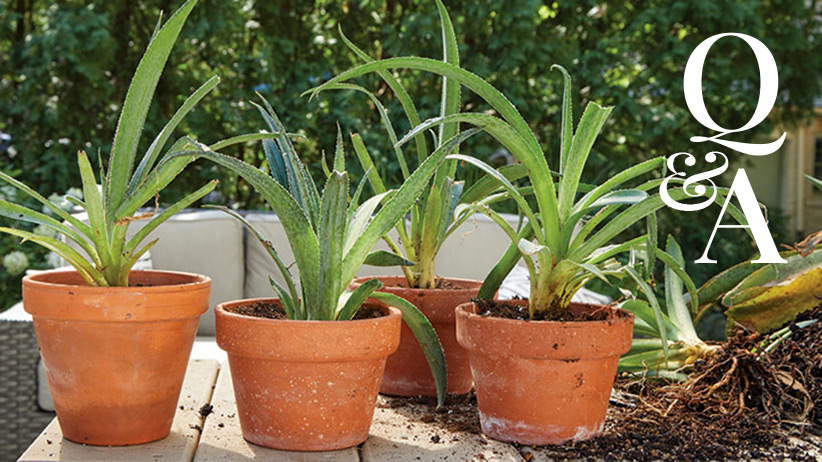Unique flowers for the garden
Have you ever bought a plant just because the flower had an interesting pattern or unusual markings? When I see a flower with bicolored petals, I am simply drawn to it. Many insects agree: Veins, stripes, picotees (a flower that is one color but the edges are another) and bicolored throats often point the way to a nectar payoff.
How to use patterned flowers in the garden
To really show off a beautifully patterned flower, pair it with other plants that are more subdued. Mixing multiple flowers with bold color patterns may create a look that is busier than you’d like. For instance, use foliage plants in shades of green to surround a container with a showy bloomer so the flower is the star. In a mixed container or garden border, use a patterned flower alongside companions with smaller blooms in a solid color that match or accent the interesting markings.
You Might Also Like:
Green Flowers for Your Garden
Add Energy to Your Garden With Orange Plants
Plants With Red Flowers and Foliage
10 Unique flowers with patterned petals
If you, too, are drawn to patterns like a bee to a blossom, here are 10 plants with unique flowers that are sure to catch your eye.

Petunia (Petunia hybrids)
With petunias, you’ll find stripes, speckles, picotees, starbursts, veins, streaks, and swirls in a huge array of colors. These tender perennials are easy to hybridize, so there are hundreds of patterned petunia cultivars for sale, with more available every year.
Flowers with veined markings, such as 16-inch-tall Headliner™ Blackberry Vein above top left, tend to be one color — a lighter shade on the petals marked with darker veins. Above top right, near-black ‘Phantom’ sports a contrasting yellow star and grows 8 to 12 inches tall and wide. The picotee on Red Carpet Hippy Chick™ Violet, above bottom left, gives the illusion of a flower inside a flower. It’s great planted in hanging baskets or containers, growing just 10 to 14 inches tall.
Petunia flowers with speckles, stripes or other markings may lose some of their coloration when night temperatures are consistently above 65 degrees F, but it will return with cooler temps. Splash Dance™ Calypso Cherry, above bottom right, is bred to hold its color pattern even in hot temperatures. It grows 10 to 12 inches tall and 18 to 24 inches wide.
Petunias come in a range of sizes and habits
Petunias are easy to grow in containers, hanging baskets or in the ground. Check the tag for size and habit, since some petunias trail and some mound. Keep them evenly moist and fertilize with a liquid, general-purpose plant food once a week. You can deadhead petunias for a tidier look, but it's not necessary. If plants start to look leggy in the heat of summer, cut back stems by a third to promote branching and more blooms.
Type Tender perennial (usually grown as an annual) Blooms White, pink, purple, red, yellow, lavender, near-black, magenta and green with many patterns on flowers that bloom from late spring to frost Light Full sun to part shade Soil Moist, well drained Size 4 to 24 in. tall, 8 to 96 in. wide Cold hardy USDA zones 10 to 11 Source Local garden centers

Tulip (Tulipa spp. and hybrids)
Tulips often have bold stripes or gentle picotee markings. Above, ‘Chopin’ shows bright red stripes on yellow petals. Even its 6- to 10-inch-tall foliage gets into patterns with broken burgundy stripes.
These tulips were bred for the striped petals. But interestingly, in the 17th century, desirable color streaks in some tulips were the result of a plant virus spread by aphids. Today, tulips with these patterns are disease-free and carefully bred to have striking irregular streaks.
Plant tulips in soil that will stay dry in the summer to prevent the dormant bulbs from rotting. Grow them near perennials that can take drier soil, such as perennial salvia (Salvia hybrids) or purple coneflower (Echinacea purpurea), and let their foliage disguise the tulip plant's leaves as it fades away.
Type Bulb Blooms Yellow, orange, white, purple, red, pink, green and bicolor flowers with streaks, picotees and stripes bloom in early to late spring Light Full sun to part shade Soil Average, well drained Size 4 to 36 in. tall, 3 to 5 in. wide Cold hardy USDA zones 3 to 8 Source Local garden centers; Holland Bulb Farms, hollandbulbfarms.com, 800-689-2852
You Might Also Like:
How To Video: Plant a Trench of Tulips
Linda Vater's Favorite Tulip Varieties
Best Places to Buy Flower Bulbs Online
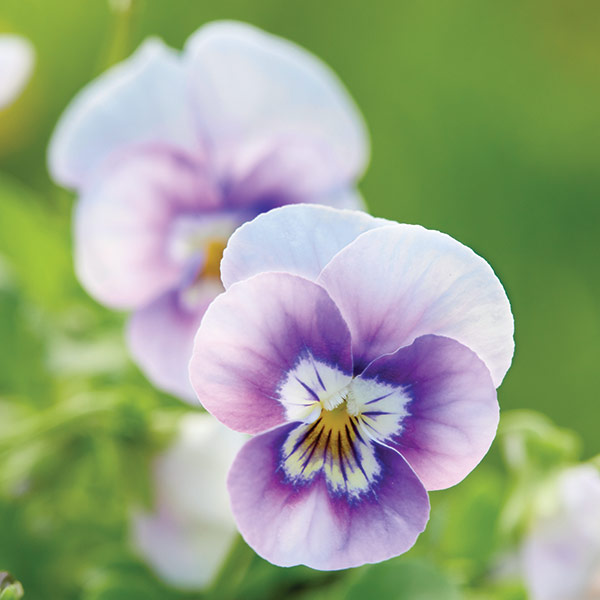
Viola (Viola hybrids)
Violas are often recognized by their cheerful “face” markings, created by colored blotches usually on the three lower petals. Above, Sorbet® XP Pink Halo’s face is outlined in a violet to pink ring, punctuated with cheeky whiskers of purple. It grows 6 to 8 inches tall and wide.
Violas are cool-weather-loving plants and may die back in the heat of summer when temps get above 80 degrees F. In the North, plant violas in early spring and again in early fall for short-term seasonal color in borders and containers. In zones where temperatures rarely get below freezing, you can plant them in the fall and expect to have blooms all winter until late spring. Deadhead spent blossoms to keep plants producing flowers.
Type Perennial Blooms Flowers in white, yellow, orange, red, blue, lavender and purple with blotches, bicolors, veins and throats in fall through spring Light Full sun to part shade Soil Moist, well drained Size 4 to 8 in. tall, 8 to 12 wide Cold hardy USDA zones 5 to 8 Source Local garden centers

Painted tongue (Salpiglossis sinuata hybrids)
Fascinating herringbonelike vein markings grace the throats of these unique, lily-shaped annual flowers. Petals range from white to near black, with dark veining over the throat, which is often a contrasting color. ‘Gloomy Rival’ above is pale lavender-gray with a burgundy-marked yellow throat. More vibrant colors of red, orange, blue, purple and yellow are available in a mix like ‘Stained Glass.’
Tips for starting painted tongue from seed
It is easier to find painted tongue seeds in specialty catalogs than plants in the garden center. Painted tongue prefers cooler temps, so start seed indoors 8 weeks before the last frost. Scatter the tiny seed in a tray of damp seed-
starting mix, dust them with a light layer of mix, then cover the tray with black paper because they need darkness to germinate. Once they’ve sprouted, remove the paper and set them under lights. When the delicate seedlings have two sets of leaves, carefully transplant them into cell packs and grow in a sunny spot or under lights, letting potting mix dry slightly between watering. Once temperatures are above 55 degrees F during the day, harden off seedlings by setting them outdoors in the morning sun for an hour at a time and increasing the time each day until plants have been acclimated.
Painted tongue plants may need some support to stand upright, so tuck them between plants in a cottage garden or mixed container. Deadhead spent flowers to keep the foliage fuller and encourage more blooms. Feed plants with a general-purpose water-soluble fertilizer once a week during the summer.
Type Annual Blooms White, lavender, purple, violet, magenta, bronze, red, orange, or yellow flowers with contrasting markings in late spring to fall Light Full sun to part shade Soil Moist, well drained Size 12 to 24 in. tall, 12 to 18 in. wide Source Select Seed, selectseeds.com, 800-684-0395 (seeds)
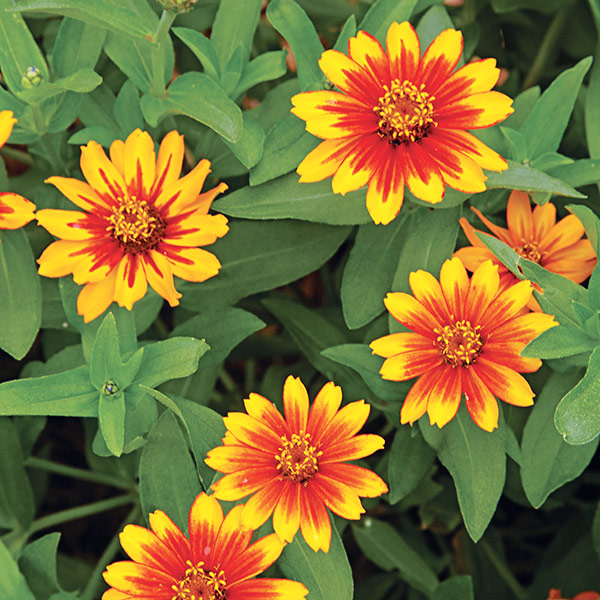
Zinnia (Zinnia spp. and hybrids)
These tough annuals’ bright colors are a mainstay in any garden. Bullseye patterns, such as the fiery orange-red and gold flowers of Zahara® Sunburst, above, advertise their nectar-rich centers to passing pollinators. This cultivar grows 12 to 18 inches tall and wide. Along with solid colors, bullseyes and picotees, zinnias can have streaks and stripes. ‘Peppermint Stick Mix’ has 2- to 4-inch-wide white, cream, yellow and orange double flowers flecked with streaks of crimson on sturdy 24-inch-tall plants perfect for the back of the border.
Zinnias are easily started indoors from seed 4 to 6 weeks before the last frost, or simply direct-sow them outdoors when temps are consistently above 50 degrees F. Grow zinnias in full sun, where they can take the heat and dry weather. If foliage starts to look dull and light-colored during a dry spell, give plants a thorough watering, being careful not to get the foliage wet. Zinnias are prone to powdery mildew in wet or humid weather, though many newer cultivars are less susceptible.
Type Annual Blooms Pink, yellow, orange, red, white, salmon, green, purple, magenta or bicolor flowers with picotees, stripes and streaks from late spring to frost Light Full sun to part shade Soil Moist, well drained Size 6 to 48 in. tall, 6 to 24 in. wide Source Local garden centers
You Might Also Like:
Clark Cottage Garden Tour
Easy Flowers to Grow
Cut Flower Garden Plan
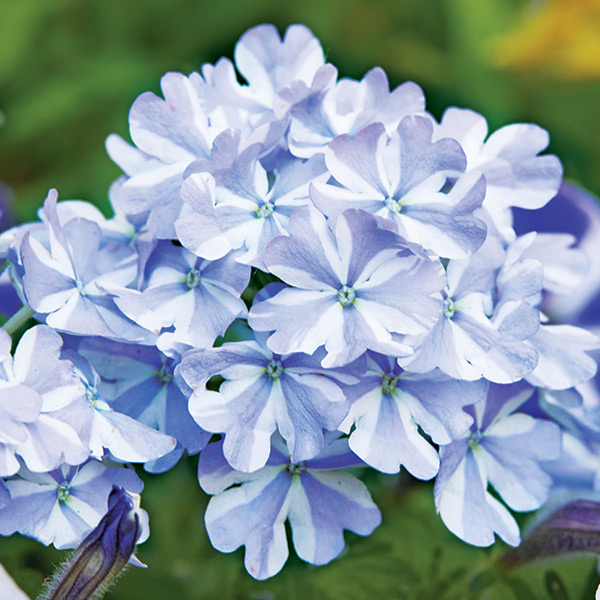
Verbena (Verbena spp. and hybrids)
Popular for mass plantings and containers, annual verbenas come in a wide range of solid colors, often with darkened throats, striking white eyes,
or stripes, such as Superbena® Stormburst above. It has a subtle color, with periwinkle and white stripes on plants 6 to 12 inches tall and 18 to 30 inches wide, perfect to trail over the side of a hanging basket or fill space in a border. Look for the bold red-and-white peppermint markings of Lanai® Candy Cane for an eye-catching focal point in a container.
Heat-tolerant verbenas love a sunny spot but will grow in part shade as well. There’s no need to deadhead these plants, but you can trim off dried blooms for a tidier look. If plants look leggy by midsummer, cut back longer stems by half to encourage branching and more blooms.
Type Tender perennial Blooms Red, pink, purple, eyes and dark throats in clusters from late spring to frost Light Full sun to part shade Soil Moist to dry Size 4 to 14 in. tall, 10 to 48 in. wide Cold hardy USDA zones 7 to 11 Source Local garden centers

Blackberry lily (Iris domestica)
Blackberry lilies are late-summer-blooming perennials with airy orange or yellow blossoms. Abundant flowers open along a long stalk and last only a day, then make way for seed pods. The species, above, grows 2 to 3 feet tall with crimson-speckled orange flowers on stalks that can reach 4 feet tall. ‘Freckle Face’ is a hybrid with the same coloration but rounder petals.
Buy blackberry lily plants at the garden center, or start them from seed indoors 6 to 8 weeks before the last frost and transplant outdoors in mid- to late spring. They prefer moist soil and full sun, but will tolerate part shade. Blackberry lilies look great in mixed borders and will easily naturalize by seed. Deadhead the flowers to extend the bloom time or to prevent reseeding.
Type Perennial Blooms Orange or yellow flowers with red speckles from late summer to fall Light Full sun to part shade Soil Moist, well drained Size 24 to 48 in. tall, 9 to 24 in. wide Cold hardy USDA zones 5 to 10 Source Select Seed, selectseeds.com, 800-684-0395 (seeds)
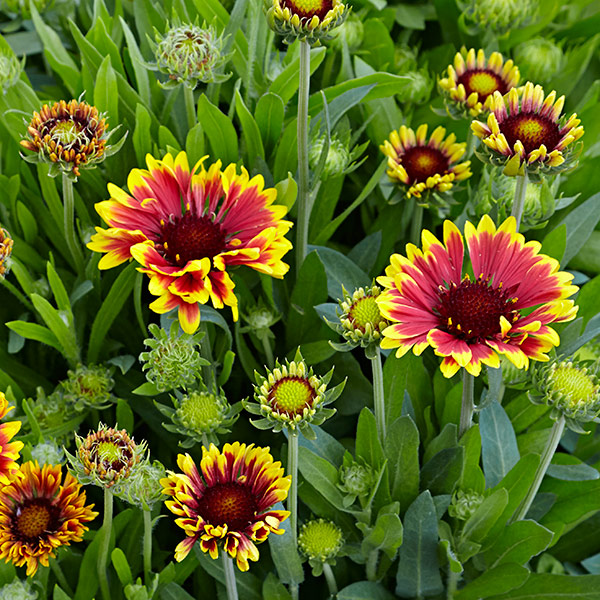
Blanket flower (Gaillardia spp. and hybrids)
Native to North America, blanket flowers are a mainstay in wildflower seed mixes. These perennials’ daisylike flowers are marked with vibrant, colorful bands that attract pollinators before flowers age and petals fall, leaving
fuzzy seedheads that birds love. The species and most cultivars have flat petals, but 6- to 8-inch-tall ‘Sun Devil,’ above, has fluted, tubular ray petals with a picotee pattern tipped in gold surrounding burgundy centers.
Blanket flowers are short-lived, but they can reseed and pop up randomly around the garden. They can be susceptible to powdery mildew, so give these plants full sun and keep the foliage dry. Deadheading and cutting back leggy stems by half in late summer can encourage more branching and abundant flowers throughout fall. But leave a few spent flowers to form seed to repopulate the border or to feed the birds.
Type Perennial Blooms Daisy-shaped red, yellow, peach, orange and bicolor flowers in early summer to frost Light Full sun to part shade Soil Dry to medium Size 6 to 36 in. tall, 12 to 24 in. wide Cold hardy USDA zones 3 to 11 Source Local garden centers

Bearded iris (Iris hybrids)
Visit a bearded iris breeder’s farm and you will be overwhelmed by the countless combinations of colors and patterns on the flowers’ upright top
petals (standards) and drooping lower petals (falls). Irregular splashes and streaks give ‘Gnus Flash’, above, a batik effect, with every blossom an original piece of art. If you prefer a more traditional pattern, ‘Stepping Out’, with purple picotee edges on white standards and falls, is a classic.
When planting bearded iris rhizomes in the fall (or potted plants anytime), make sure to cover only the roots, leaving the rhizomes exposed so they don’t get too wet and rot. Water plants in, then let them dry before the next watering. Apply a low-nitrogen granular fertilizer in early spring as plants emerge, then again a month after they finish blooming. Divide bearded iris rhizomes every 3 to 5 years to prevent overcrowding, which will reduce the number of blooms the plant can produce.
Type Perennial Blooms Flowers in all shades of white, peach, pink, magenta, red, rust, maroon, yellow, orange, purple, lavender, blue and near-black with many patterns on bloom stalks in late spring to early summer Light Full sun Soil Moist, well drained Size 8 to 40 in. tall, 18 to 24 in. wide Cold hardy USDA zones 4 to 9 Source Schreiner’s Iris Gardens, schreinersgardens.com, 800-525-2367

Toad lily (Tricyrtis spp. and hybrids)
Intricate and orchidlike, perennial toad lilies’ small blossoms are sprinkled with purple specks that give them an exotic look. Flowers form in small clusters along the unbranched stem in the leaf axils and at the stem ends. Try cultivars with variegated leaf edges, such as ‘Gilt Edge’ or ‘Variegata’, to add a bit more color to a woodsy border.
Toad lilies prefer damp soil and a shady spot so they don’t dry out, scorching their foliage. They grow well in a woodland garden, but plant them close to a path or bench so you can see these interesting flowers up close. Cut back dead stems in early spring to make way for new shoots.
Type Perennial Blooms White to lavender flowers with purple speckles form alone or in small clusters along the stem from late summer to fall Light Part to full shade Soil Moist Size 10 to 36 in. tall, 12 to 24 in. wide Cold hardy USDA zones 4 to 8 Source Plant Delights Nursery, plantdelights.com, 919-772-4794



